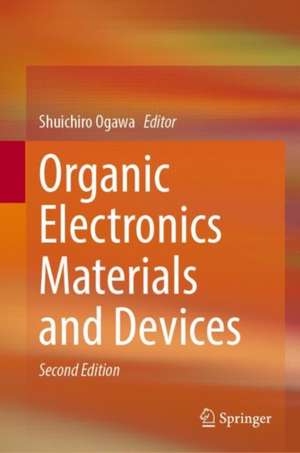Organic Electronics Materials and Devices
Editat de Shuichiro Ogawaen Limba Engleză Hardback – 25 ian 2024
Preț: 710.42 lei
Preț vechi: 835.79 lei
-15% Nou
Puncte Express: 1066
Preț estimativ în valută:
135.95€ • 141.08$ • 113.63£
135.95€ • 141.08$ • 113.63£
Carte disponibilă
Livrare economică 22 februarie-08 martie
Preluare comenzi: 021 569.72.76
Specificații
ISBN-13: 9784431569350
ISBN-10: 4431569359
Pagini: 345
Ilustrații: IX, 345 p. 1 illus.
Dimensiuni: 155 x 235 mm
Greutate: 0.79 kg
Ediția:2nd ed. 2024
Editura: Springer
Colecția Springer
Locul publicării:Tokyo, Japan
ISBN-10: 4431569359
Pagini: 345
Ilustrații: IX, 345 p. 1 illus.
Dimensiuni: 155 x 235 mm
Greutate: 0.79 kg
Ediția:2nd ed. 2024
Editura: Springer
Colecția Springer
Locul publicării:Tokyo, Japan
Cuprins
Chapter 1. Physics of Organic Field Effect Transistors and the Materials.- Chapter 2. Organic Light Emitting Diodes (OLEDs) -Materials, Photophysics and Device Physics.- Chapter 3. Organic solar cells.- Chapter 4. Printed Organic Thin-Film Transistors and Integrated Circuits.- Chapter 5. Ultra-flexible organic electronics.- Chapter 6. Polymer Nanosheets with Printed Electronics for Wearable and Implantable Devices.- Chapter 7. Solution Processed Organic LEDs and Perovskite LEDs.- Chapter 8. Transient Properties and Analysis of Organic Photonic Devices.- Chapter 9. Microfluidic self-emissive devices.
Notă biografică
Shuichiro Ogawa completed his master's degree at the Tokyo Institute of Technology in 1986 with work on surface science. He also completed a PhD in Material Science in 2000 at the same university. He joined Asahi Kasei Corporation as a researcher in 1986. He researched and developed photosensitive materials, optical disks materials, photoelectrochemical nano-materials, and electrochemical catalysts. From 1993 to 1995, he studied the photoelectrochemistry of nano-particles at The University of Texas at Austin. From 2000 to 2004, he was a Corporate R&D representative at the London office of Asahi Kasei, where he created and managed several R&D projects involving European organizations. Then he has been working as a general manager in the development of materials for solar energy, in Analysis & Simulation Center, in Planning & Control department and in Innovation Strategy Department of Corporate R&D . Since 2021, he is now a senior manager there.
Textul de pe ultima copertă
This book is an introductory text for graduate students, researchers in industries, and those who are just beginning to work on organic electronics materials, devices and their applications. The book includes mainly fundamental principles and theories for understanding organic electronics materials and devices, but also provides information about state-of-the-art technologies, applications and future prospects. These topics encompass physics for organic transistors, structure control technologies of polymer semiconductors, nanomaterials electronics, organic solar cells, organic electroluminescence and dynamics for excitation, among others. In this second edition, the topics that have had particular progress in the field of organic electronics over the past seven years were added. For example, Thermally Activated Delayed Fluorescence (TADF) technology for organic LED, the development of perovskite materials, light-emitting materials using nanomaterials and the development of skin sensors and wearable/embedded devices. The recent scientific understanding of organic electronics is also introduced. This book will help readers to be able to contribute to society with the technologies and science of organic electronics materials in the future.
Caracteristici
Presents the basic principles and theories of organic electronics materials Easy to understand information from perspective of both chemistry and physics Includes insights into recent developments over the last decade
